50 years ago, 1972's Hurricane Agnes killed 122 people and caused more than $2 billion in damage in eastern US
Hurricane Agnes in June 1972 dumped up to 19 inches of rain in Pennsylvania
50 years since Hurricane Agnes struck the eastern U.S. with historic, deadly flooding
Agnes was one of the largest June hurricanes to ever roam the Atlantic Basin. According to the National Hurricane Center, its circulation spanned about 1,150 miles in diameter.
This week marks the 50th anniversary of the historic, deadly flooding spawned by Hurricane Agnes and its remnants in June 1972 across the eastern U.S., including the hardest-hit states of Pennsylvania and New York.
Agnes was one of the largest June hurricanes to ever roam the Atlantic Basin. According to the National Hurricane Center, its circulation spanned about 1,150 miles in diameter.
HOW TO WATCH FOX WEATHER ON TV
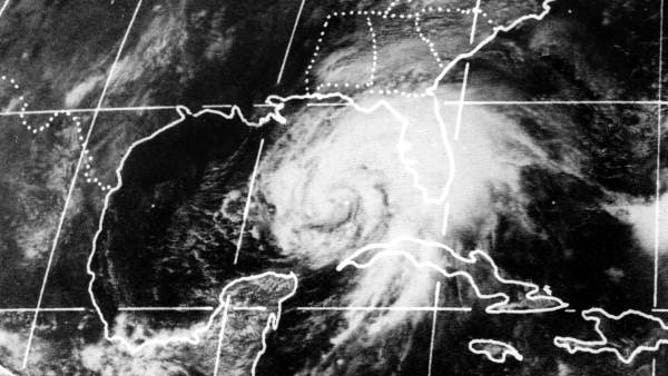
Satellite imagery shows Agnes churning through the Gulf of Mexico on June 18, 1972.
(NOAA)
The storm's origins can be traced back to Mexico and the Caribbean.
A large disturbance was first detected over the Yucatán Peninsula of Mexico on June 14, 1972. This system drifted eastward and organized into a tropical depression later that day after emerging over the northwestern Caribbean Sea.
WHERE TROPICAL STORMS, HURRICANES TYPICALLY OCCUR DURING EACH MONTH OF ATLANTIC HURRICANE SEASON
Feeding off the warm waters of the Caribbean, the depression reached tropical storm strength (winds of at least 39 mph) early on June 16.
Agnes was officially born.
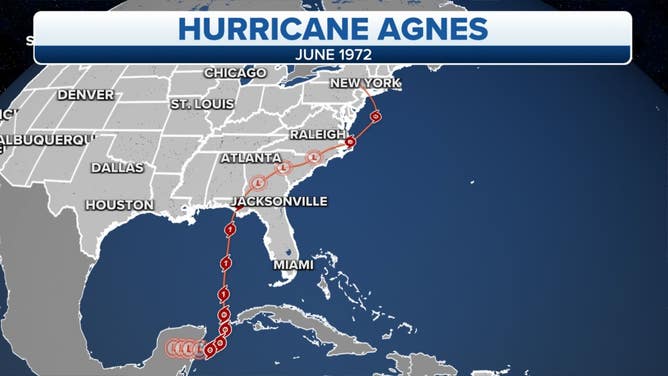
The track of Hurricane Agnes in June 1972.
(FOX Weather)
The newly formed tropical storm turned northward on June 17 and continued to intensify. Agnes became a Category 1 hurricane over the southeastern Gulf of Mexico on June 18 when NOAA reconnaissance aircraft detected sustained winds of 85 mph.
Hurricane Agnes continued on its northward trajectory, which sent it in the direction of the Florida Panhandle, where it made landfall on June 19 with maximum sustained winds of 75 mph, barely at Category 1 strength. According to the NHC, the highest wind gust reported on land was 55 mph in Apalachicola, Florida.
Agnes turned northeastward after landfall and quickly weakened to a tropical depression over Georgia by June 20.
WHAT'S THE DIFFERENCE BETWEEN A TROPICAL DEPRESSION, TROPICAL STORM AND HURRICANE?
However, after Agnes merged with a secondary non-tropical low-pressure system situated to its west, it was able to regain tropical storm strength over eastern North Carolina on June 21. The center of the storm moved offshore near Norfolk, Virginia, that evening, and it continued to regain strength over the western Atlantic Ocean.
Agnes then made a northwestward turn and was on a collision course with the Northeast and mid-Atlantic coasts, setting the stage for the torrential rainfall that would result in historic flooding across the eastern U.S. over the coming days.
On June 22, Agnes made its second landfall just shy of hurricane strength on the western tip of Long Island, near New York City, with estimated winds of 70 mph.
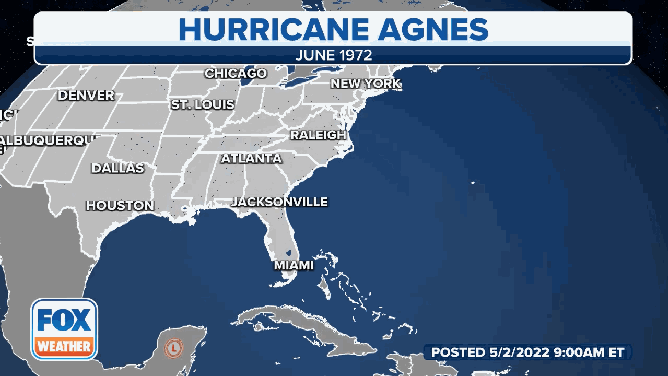
The track of Hurricane Agnes in June 1972.
(FOX Weather)
Agnes' main circulation center dissipated over Connecticut that night, with the secondary low-pressure system then taking over as the dominant circulation as it moved into northeastern Pennsylvania.
These remnants of Agnes stalled over the region and continued to drench the eastern U.S. until June 25.
HOW HEAVY IS IT REALLY GOING TO RAIN?
Agnes unleashes historic, deadly flooding
50 years ago, 1972's Hurricane Agnes struck the eastern US
This week marks the 50th anniversary of the historic, deadly flooding spawned by Hurricane Agnes and its remnants in June 1972 across the eastern U.S., including the hardest-hit states of Pennsylvania and New York.
The worst impacts were felt in the Northeast and mid-Atlantic states, where widespread rainfall totals greater than 10 inches were recorded from northern Virginia to the Finger Lakes of New York. Localized areas picked up 14 to 19 inches of rain.
According to NOAA's Weather Prediction Center, the highest total of 19 inches was measured in western Schuylkill County in eastern Pennsylvania's Coal Region.
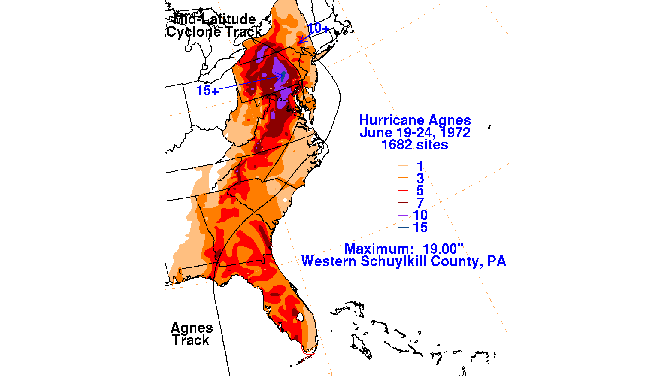
A map showing how much rain fell in association with Hurricane Agnes and its remnants in the eastern U.S.
(NOAA's Weather Prediction Center)
The torrential rainfall produced widespread severe flooding from Virginia northward to New York state. Additional flooding also occurred in the western Carolinas.
Several rivers rose to all-time record crests because of the heavy rains, which led to the inundation of homes, businesses, factories, bridges and other infrastructure, resulting in very significant damage.
Some of the most extensive flooding was observed along the Susquehanna River in Elmira, New York, and Wilkes-Barre, Pennsylvania.
EXPLAINING FLOOD ALERTS ISSUED BY THE NATIONAL WEATHER SERVICE
In Elmira, 20,000 people were forced to evacuate their homes as the river overflowed its banks and flooded the city, according to the University of Rhode Island. As that water rushed downstream, the flooding caused a dike to be breached in Wilkes-Barre, resulting in the near destruction of the entire city.

Floodwaters were seen rushing down a street in Elmira, New York, as the remnants of Hurricane Agnes dumped torrential rainfall across the region in June 1972.
(NWS Binghamton)
The University of Rhode Island also noted the rising Susquehanna River flooded the Pennsylvania capital of Harrisburg, where the governor's mansion was submerged in floodwaters.
"It is difficult, if not impossible, to determine how much of the rainfall might have occurred separately from the baroclinic system had Agnes not been located to the east," the NHC wrote in its tropical cyclone report for Hurricane Agnes. "Regardless of the energy sources and circulation dynamics that caused the floods, however, this devastation could not have occurred without the extreme importations of moisture to the area by the depression that had been Hurricane Agnes."
Agnes and its remnants were responsible for 122 deaths, of which 113 were associated with the flooding in the eastern U.S. The other nine deaths were caused by severe thunderstorms and tornadoes spawned by Agnes in Florida. Seven additional deaths were also blamed on Agnes in western Cuba.
WATER FROM HURRICANES, TROPICAL STORMS KILLS MORE IN U.S. THAN WIND
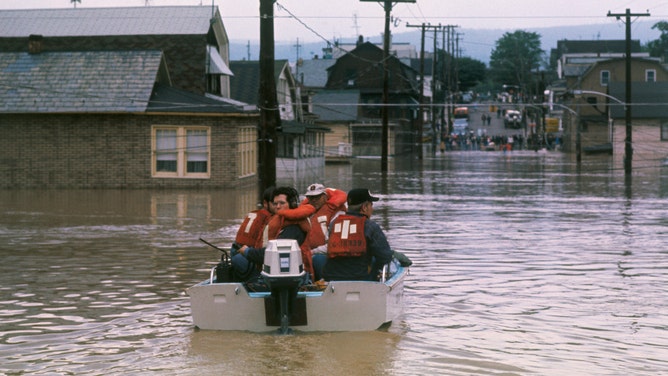
Rescue workers in a motorboat ride through a flooded Wilkes-Barre, Pennsylvania, street on June 24, 1972, searching for people stranded in homes. More than 100,000 people in the Wilkes-Barre area had to be evacuated as a result of flooding caused by the remnants of Hurricane Agnes. Wilkes-Barre was flooded when the Susquehanna River crested at 43 feet, more than 20 feet above the flood stage. Referring to the situation throughout the state, Governor Milton Shapp said, "Without a doubt, this is the worst disaster in the history of Pennsylvania."
(Bettmann / Getty Images)
Agnes was responsible for $2.1 billion in damage in the U.S., mostly as a result of the historic flooding.
At the time, Agnes was the nation's costliest natural disaster on record, far exceeding the combined losses from Hurricane Betsy in 1965 and Hurricane Camille in 1969, which had previously been the nation's two most destructive storms, according to the NHC.
CLICK HERE TO GET THE FOX WEATHER UPDATE PODCAST
It should come as no surprise that the World Meteorological Organization voted to retire the name "Agnes" from being used again for a future Atlantic Basin tropical storm or hurricane, joining a list of 94 total retirees through 2021.

